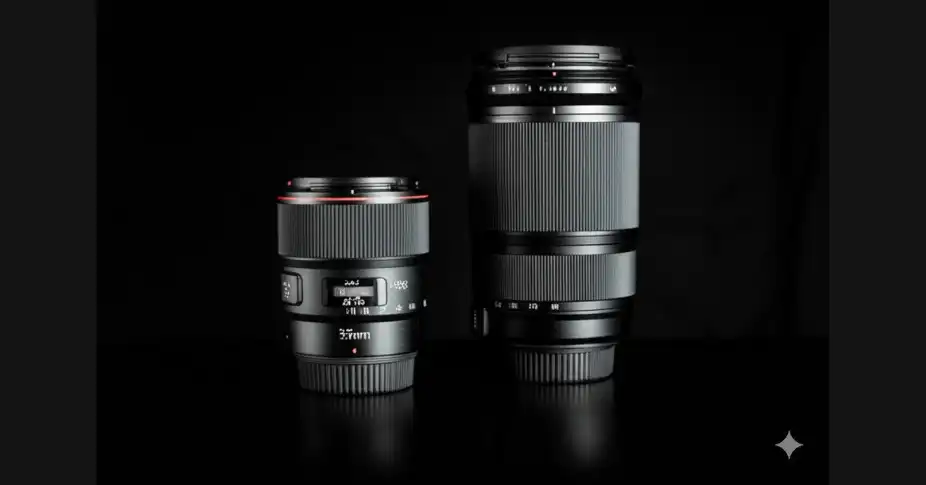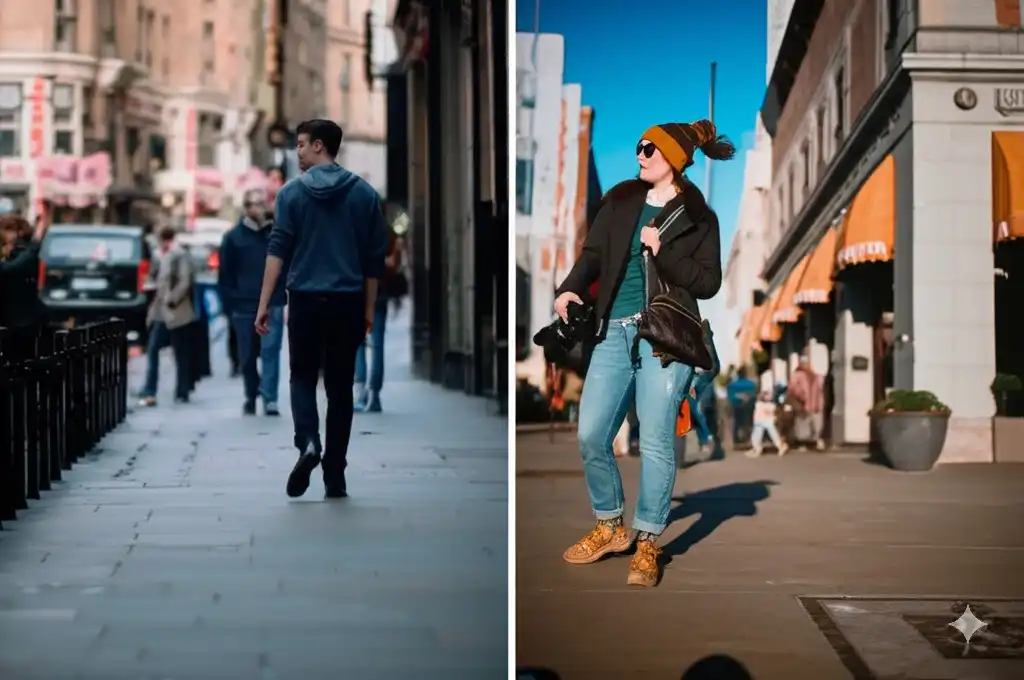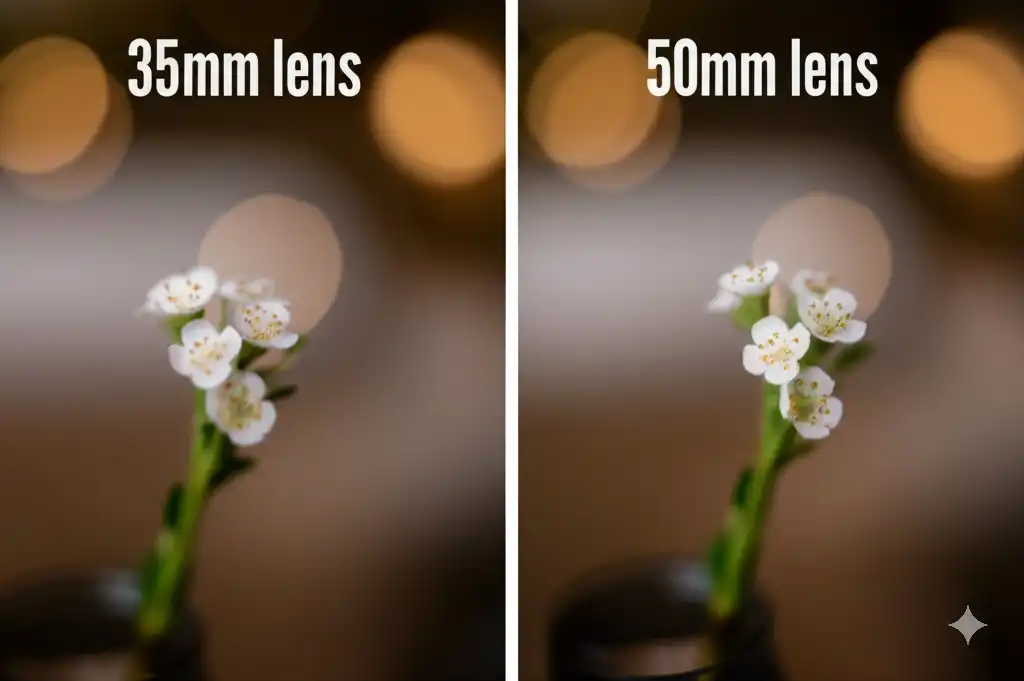Choosing the right lens is a pivotal decision for photographers, and the debate between 35mm and 50mm lenses is one of the most common among beginners and professionals alike. Both are prime lenses known for their versatility, sharpness, and ability to produce stunning images, but they serve different purposes based on focal length, perspective, and use case. This comprehensive guide compares the 35mm and 50mm lenses, focusing on their technical specifications, practical applications, and creative potential to help you decide which lens best suits your photography needs. Optimized for search intent, this chapter addresses common questions like “Which lens is better for portraits?” or “Should I buy a 35mm or 50mm lens?” while providing actionable insights for photographers at all levels.
35mm vs 50mm Lens Comparison Table
| Feature | 35mm Lens | 50mm Lens |
| Focal Length | 35mm (wider, ~63° field of view on full-frame) | 50mm (narrower, ~47° field of view on full-frame) |
| Effective Focal Length (APS-C) | ~50–56mm (like 50mm on full-frame) | ~75–80mm (portrait telephoto) |
| Perspective | Wider, includes more context; slight distortion at close range | Natural, mimics human eye; minimal distortion |
| Depth of Field/Bokeh | Shallow at f/1.8 or f/1.4; less pronounced bokeh than 50mm | Shallower at same aperture; creamier bokeh for subject isolation |
| Best Use Cases | Street, environmental portraits, landscapes, events, travel, vlogging | Classic portraits, headshots, product photography, interviews, cinematic shots |
| Distortion | Minor barrel distortion, especially at close distances | Virtually distortion-free, ideal for accurate rendering |
| Low-Light Performance | Excellent (f/1.8 or f/1.4); great for indoor or night street photography | Excellent (f/1.8 or f/1.4); ideal for low-light portraits or product shots |
| Size/Weight | Compact, lightweight (e.g., Canon 35mm f/1.8 ~210g) | Slightly larger but compact (e.g., Sony 50mm f/1.8 ~186g) |
| Price Range | ~$200 (e.g., Nikon 35mm f/1.8G) to ~$900 (e.g., Sigma 35mm f/1.4 Art) | ~$125 (e.g., Canon 50mm f/1.8 STM) to ~$4,000 (e.g., Zeiss Otus 50mm f/1.4) |
| Video Suitability | Ideal for wide shots, vlogging, documentaries in tight spaces | Best for interviews, close-ups, stylized cinematic shots |
| Portability | Highly portable, great for travel or street photography | Equally portable, suits studio or on-location portrait shoots |
| Beginner-Friendly | Versatile for learning multiple genres | Affordable and great for mastering portraiture and low-light shooting |
Understanding Focal Length and Prime Lenses
What is Focal Length?
Focal length, measured in millimeters (mm), determines a lens’s field of view and magnification. A 35mm lens has a wider field of view, capturing more of the scene, while a 50mm lens is closer to the human eye’s perspective, offering a narrower, more focused view. Both are prime lenses, meaning they have a fixed focal length, resulting in superior sharpness, faster apertures (e.g., f/1.8 or f/1.4), and better low-light performance compared to zoom lenses.
Why Compare 35mm vs 50mm?
The 35mm and 50mm lenses are popular for their versatility across genres like portrait, street, landscape, and event photography. They’re often the first prime lenses photographers buy due to their affordability and performance. Understanding their differences helps you choose the right tool for your creative vision, whether you’re shooting on a full-frame, APS-C, or mirrorless camera.
Technical Specifications
35mm Lens
- Field of View: Approximately 63° on a full-frame camera, wider than the human eye. On APS-C sensors (1.5x or 1.6x crop), it behaves like a 50–56mm lens.
- Aperture: Commonly available in f/1.4, f/1.8, or f/2, allowing excellent low-light performance and shallow depth of field.
- Distortion: Slight barrel distortion at the edges, especially at wide apertures, but minimal for most modern lenses.
- Weight and Size: Typically compact and lightweight (e.g., Canon EF 35mm f/1.8 weighs ~210g).
- Price: Affordable options like the Nikon AF-S 35mm f/1.8G ($200) or premium models like the Sigma 35mm f/1.4 Art ($900).
50mm Lens
- Field of View: Approximately 47° on a full-frame camera, mimicking human vision. On APS-C sensors, it behaves like a 75–80mm lens, ideal for portraits.
- Aperture: Available in f/1.2, f/1.4, or f/1.8, offering creamy bokeh and low-light capabilities.
- Distortion: Virtually distortion-free, producing natural-looking images.
- Weight and Size: Slightly larger than 35mm lenses but still compact (e.g., Sony FE 50mm f/1.8 weighs ~186g).
- Price: Budget-friendly (e.g., Canon EF 50mm f/1.8 STM ~$125) to high-end (e.g., Zeiss Otus 50mm f/1.4 ~$4,000).
Crop Sensor Considerations
On APS-C cameras, the effective focal length changes due to the crop factor:
- 35mm lens → ~50–56mm (similar to a 50mm on full-frame).
- 50mm lens → ~75–80mm (closer to a portrait telephoto lens).
For crop sensor users, a 35mm lens is often preferred for general-purpose shooting, while a 50mm leans toward portraiture.
Visual and Creative Differences

Perspective and Field of View
- 35mm Lens: The wider field of view captures more context, making it ideal for environmental portraits, street photography, and landscapes. It allows you to include background elements, creating a storytelling effect. However, it can exaggerate perspective when shooting close-up, making subjects (e.g., faces) appear slightly stretched.
- 50mm Lens: The tighter field of view isolates subjects, emphasizing them against the background. It produces a natural perspective with minimal distortion, perfect for headshots, product photography, or situations where the subject needs to stand out.
Depth of Field and Bokeh
Both lenses offer shallow depth of field at wide apertures (e.g., f/1.8), creating pleasing bokeh (blurred background). However:
- 35mm Lens: Requires you to be closer to the subject to achieve a shallow depth of field, which can enhance intimacy in portraits but may include more background.
- 50mm Lens: Achieves a shallower depth of field at the same aperture due to its longer focal length, producing creamier bokeh and better subject-background separation.
Distortion and Rendering
- 35mm Lens: Slight barrel distortion can occur, especially at close distances or with cheaper lenses. Modern lenses correct this effectively, but it’s noticeable in architectural or straight-line shots.
- 50mm Lens: Near-zero distortion makes it a go-to for accurate rendering, such as in portraiture or product photography where proportions matter.
Practical Applications
Portrait Photography
- 35mm Lens: Excels in environmental portraits, capturing the subject and their surroundings (e.g., a model in a café or park). It’s less flattering for close-up headshots due to perspective distortion.
- 50mm Lens: The gold standard for portraits, especially on full-frame cameras. Its natural perspective and shallow depth of field create flattering, professional headshots with beautiful bokeh.
Winner: 50mm for classic portraits, 35mm for storytelling or group shots.
Street Photography

- 35mm Lens: The wider field of view captures dynamic street scenes, candid moments, and urban environments. It allows you to shoot in tight spaces without stepping back too far.
- 50mm Lens: Better for isolating subjects (e.g., a street performer) but requires more distance, which can be challenging in crowded areas.
Winner: 35mm for its versatility and contextual capture.
Landscape and Travel Photography
- 35mm Lens: Wide enough to capture expansive scenes like cityscapes or nature, while still maintaining a natural perspective. It’s a favorite for travel photographers who want a single lens for diverse scenarios.
- 50mm Lens: Less ideal for landscapes due to its narrower field of view but useful for isolating specific elements (e.g., a tree or monument).
Winner: 35mm for its broader perspective.
Event Photography
- 35mm Lens: Great for capturing group shots, dance floors, or venue ambiance at weddings or parties. Its wider angle ensures you don’t miss key moments in dynamic settings.
- 50mm Lens: Ideal for candid portraits or detail shots (e.g., rings, decor) but may require more movement to frame wider scenes.
Winner: 35mm for versatility, 50mm for intimate moments.
Low-Light Photography
Both lenses perform exceptionally in low light due to their fast apertures (f/1.8 or f/1.4). The 35mm’s wider field of view is better for indoor or night street photography, while the 50mm’s tighter frame suits low-light portraits or product shots.
Winner: Tie, depending on the scenario.
Video Production
- 35mm Lens: Preferred for vlogging, documentaries, or cinematic wide shots due to its contextual field of view. It’s forgiving for handheld shooting in tight spaces.
- 50mm Lens: Ideal for interviews, talking-head videos, or cinematic close-ups with a shallow depth of field.
Winner: 35mm for general video, 50mm for stylized shots.
Equipment and Setup Considerations
Camera Compatibility
Both 35mm and 50mm lenses are available for major camera systems (Canon, Nikon, Sony, Fujifilm, etc.) in full-frame and APS-C formats. Ensure the lens mount matches your camera (e.g., Canon EF, Sony E). Mirrorless cameras may require adapters for DSLR lenses.
Filters and Accessories
Both lenses support standard filters (e.g., UV, ND, polarizing) for creative effects or protection. The 50mm lens often has a slightly larger filter thread (e.g., 52mm vs. 49mm for 35mm), which may affect accessory costs.
Tripod Use
For precise compositions (e.g., product photography), use a sturdy tripod with either lens. The 35mm benefits from a tripod in landscape or architectural shots, while the 50mm is often used handheld for portraits due to its fast aperture.
Post-Production
Both lenses produce sharp, high-quality images requiring minimal post-processing. Common edits include:
- Color Correction: Adjust white balance to ensure accurate skin tones or product colors.
- Sharpening: Enhance details like textures or edges using Adobe Lightroom or Photoshop.
- Distortion Correction: Apply lens profiles in editing software (e.g., Lightroom’s Lens Correction) to fix minor barrel distortion in 35mm shots.
- Bokeh Enhancement: Use selective blur tools to refine background bokeh, especially for 50mm portraits.
For video, both lenses benefit from stabilization in post-production (e.g., Adobe Premiere Warp Stabilizer) if shot handheld.
Pros and Cons
35mm Lens
Pros:
- Wider field of view for contextual storytelling.
- Versatile for street, landscape, and event photography.
- Compact and lightweight.
- Better for tight spaces or group shots.
Cons:
- Slight distortion at close distances.
- Less flattering for close-up portraits.
- Bokeh less pronounced compared to 50mm.
50mm Lens
Pros:
- Natural perspective, ideal for portraits and product photography.
- Minimal distortion for accurate rendering.
- Creamier bokeh at wide apertures.
- Often cheaper than 35mm lenses.
Cons:
- Narrower field of view limits contextual capture.
- Requires more space to frame shots.
- Less versatile for wide scenes.
Choosing the Right Lens for You
When to Choose a 35mm Lens
- You shoot street, travel, or environmental portraits.
- You need a versatile lens for multiple genres.
- You work in tight spaces (e.g., indoors, crowded streets).
- You want to capture more context or group shots.
- You’re a vlogger or documentary filmmaker.
When to Choose a 50mm Lens
- You focus on classic portraiture or headshots.
- You need a lens for product or food photography.
- You want a natural perspective with minimal distortion.
- You prioritize creamy bokeh and subject isolation.
- You’re shooting interviews or cinematic close-ups.
Budget Considerations
If cost is a factor, the 50mm lens is often more affordable (e.g., Canon EF 50mm f/1.8 STM at ~$125 vs. Canon EF 35mm f/1.8 at ~$300). However, premium 35mm lenses (e.g., Sigma 35mm f/1.4 Art) offer unmatched sharpness and build quality for professionals.
Should You Get Both?
Many photographers own both lenses for their complementary strengths. If you can only choose one, consider your primary genre and shooting style. Test both lenses at a camera store or rent them (e.g., via LensRentals) to compare hands-on.
Advanced Considerations
Lens Quality and Brand
High-end lenses (e.g., Canon L-series, Nikon G, Sony GM) offer better build quality, weather sealing, and optical performance but come at a premium. Third-party brands like Sigma Art, Tamron, or Yongnuo provide excellent value for budget-conscious photographers. Compare lens reviews on sites like DXOMark or LensTip for sharpness, chromatic aberration, and vignetting data.
Bokeh and Aperture
For portrait photographers, the aperture matters. A 50mm f/1.4 or f/1.2 lens produces dreamier bokeh than an f/1.8, but the difference is subtle. The 35mm f/1.4 is ideal for low-light street or event shooters who need both bokeh and context.
Autofocus vs. Manual Focus
Most modern 35mm and 50mm lenses feature fast, silent autofocus (e.g., Canon STM, Sony FE). Manual focus lenses (e.g., Zeiss Milvus) are preferred by videographers or purists for precise control but may slow down fast-paced shoots.

Lens Flare and Coatings
Premium lenses have advanced coatings to reduce flare and ghosting, which is critical for backlit shots (e.g., golden hour portraits). The 35mm lens, with its wider field of view, is more prone to flare, so use a lens hood or position lights carefully.
Need expert photo editing? Explore our services and let’s bring your vision to life.
Conclusion
The 35mm and 50mm lenses are both exceptional tools, each excelling in different scenarios. The 35mm is your go-to for capturing wide, contextual scenes in street, travel, or event photography, while the 50mm shines in portraiture, product shots, and situations requiring a natural perspective. Your choice depends on your shooting style, genre, and budget. By understanding their technical differences, creative applications, and practical uses, you can confidently select the lens that aligns with your vision. Experiment with both, if possible, to unlock their full potential and elevate your photography to new heights.
Frequently Asked Questions (FAQs)
- Which lens is better for beginners, 35mm or 50mm?
For beginners, the 50mm lens is often recommended due to its affordability (e.g., Canon 50mm f/1.8 at ~$125), versatility, and natural perspective. It’s ideal for learning portraiture and low-light photography. However, if you prefer street or travel photography, the 35mm lens offers more flexibility with its wider field of view. - Can I use a 35mm or 50mm lens on a crop sensor camera?
Yes, both lenses work on crop sensor cameras, but the effective focal length changes. A 35mm lens becomes ~50–56mm, and a 50mm lens becomes ~75–80mm due to the crop factor (1.5x or 1.6x). The 35mm is more versatile for general use on APS-C, while the 50mm leans toward portraiture. - Is a 50mm lens really like human vision?
Yes, on a full-frame camera, the 50mm lens closely mimics the human eye’s field of view (~47°) and perspective, producing images that feel natural and undistorted. This makes it a favorite for portrait and documentary photography. - Which lens is better for video, 35mm or 50mm?
The 35mm lens is better for video in most cases, especially for vlogging, documentaries, or wide cinematic shots, due to its wider field of view and ability to capture context. The 50mm lens is ideal for interviews, close-ups, or stylized videos with a shallow depth of field. - Do I need both a 35mm and 50mm lens?
While not necessary, owning both lenses is common among photographers for their complementary strengths. The 35mm excels in wide, contextual shots, while the 50mm is unmatched for portraits and isolation. If budget allows, both can cover nearly all photography genres.